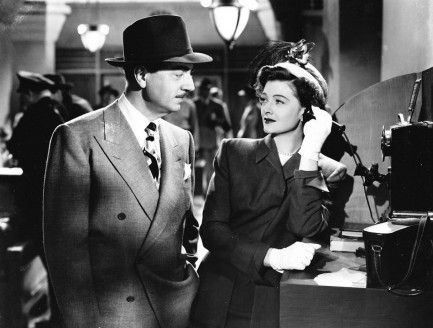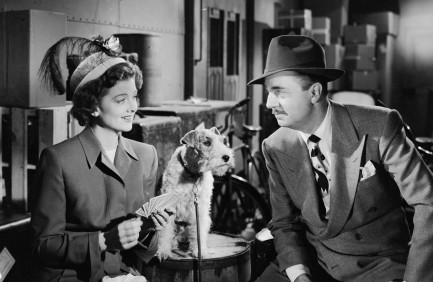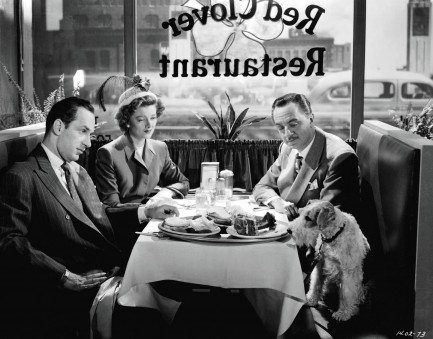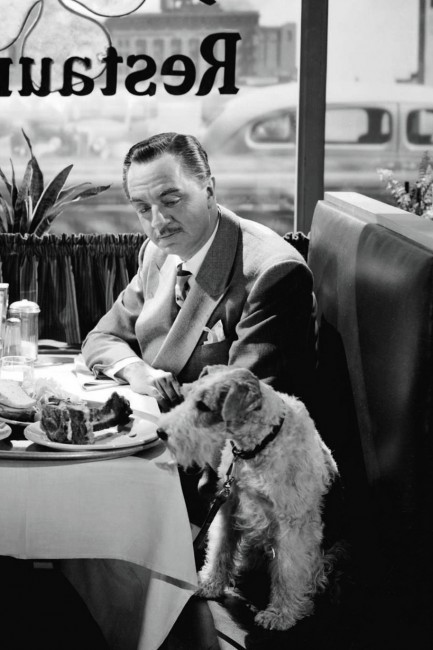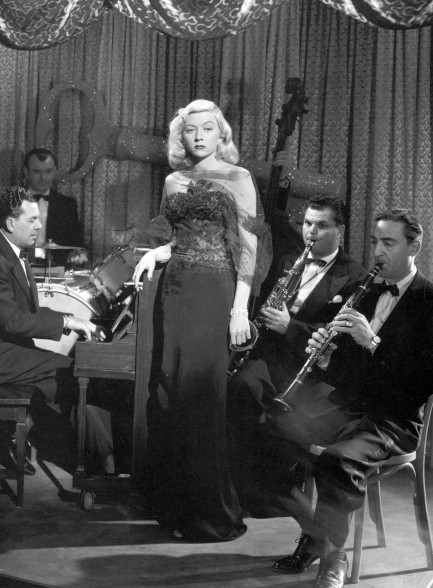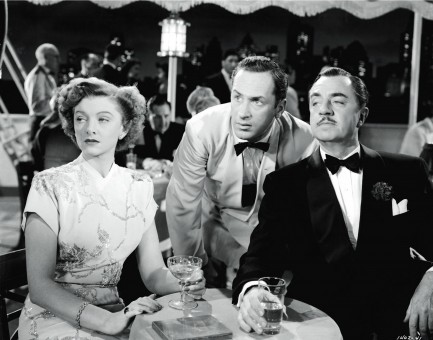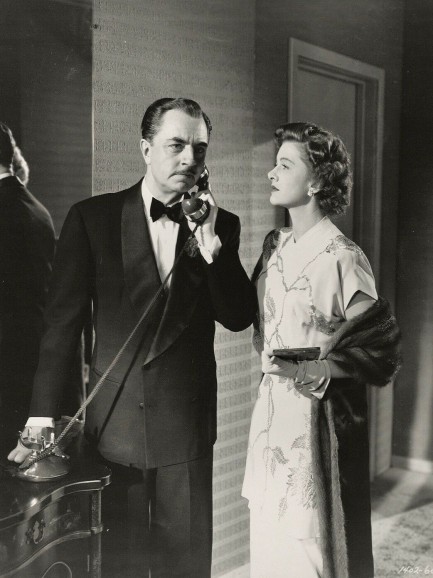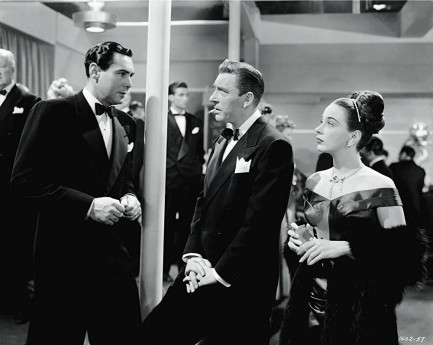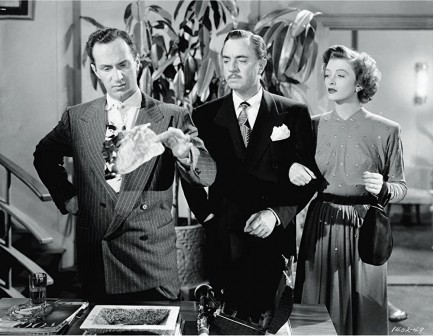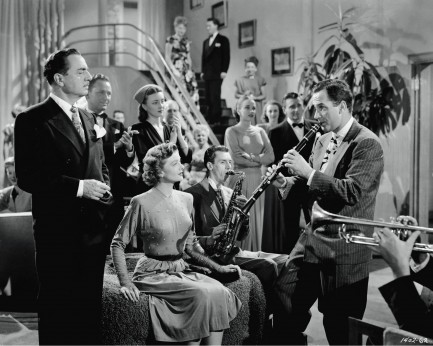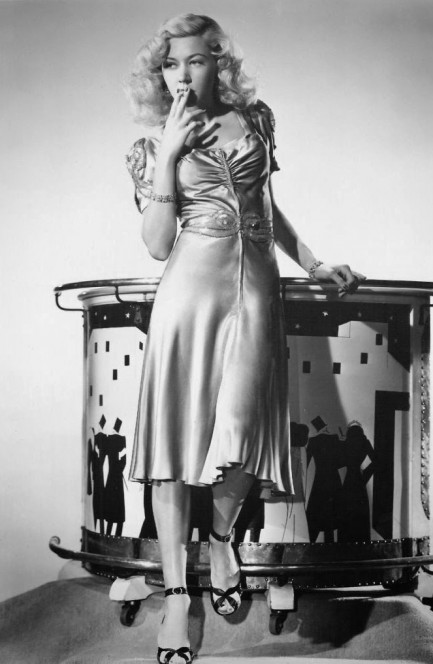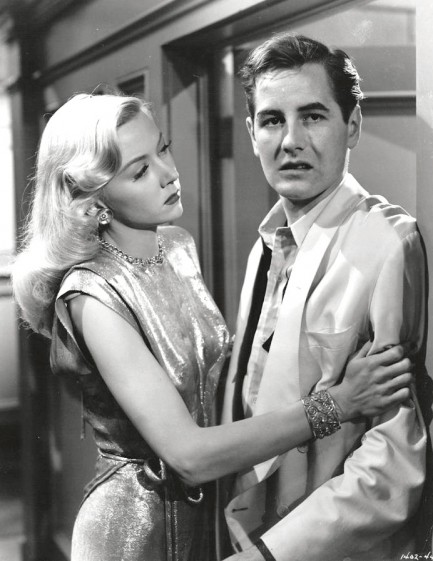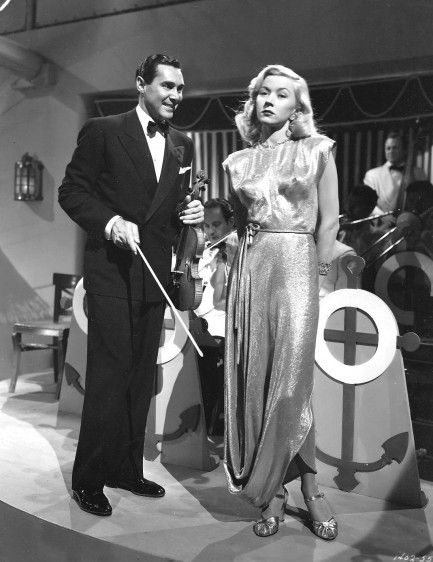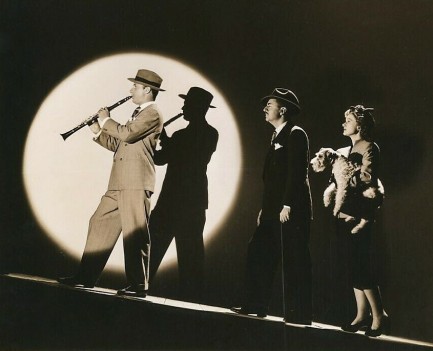 Gloria Grahame is a bad mamma scamma. 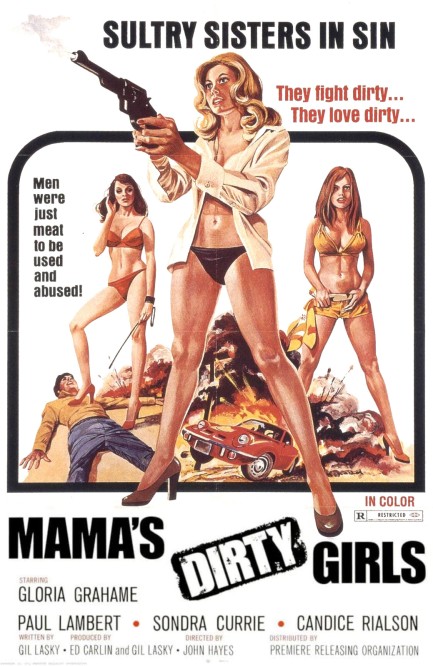
We had to watch Mama's Dirty Girls, not because it's a 1970's grindhouse movie (though that helped), but because none other than 1950s femme fatale Gloria Grahame got snared in this low budget affair. Sometimes the bills simply need to be paid. Or maybe she thought the script was dynamite. Either way, she gets top billing in this drive-in quality drama that premiered today in 1974, which tells the story of a scam artist mother and her three daughters who are honeytrap serial killers dispatching men for their money.
When Grahame gets another rich man on the hook, she foolishly poses as a well-to-do widow without realizing that her target is likewise seeking to kill someone for their money. This twist is ironic, and the mutual murder attempts that follow can be read as black comedy if you peer deeply between the lines, but in our opinion Mama's Dirty Girls doesn't have enough brainpower to be satire. Grahame probably wished it were, though—then she'd have had an excuse for starring in it. Sadly, it's just an amusingly bad movie. Everyone is terrible in it—even Grahame. And there isn't near enough eroticism to save it.
But you may want to watch it anyway. The cast is beautiful, particularly Currie, and there's an interesting value-added co-star too. Fifteen minutes into the movie's running time you'll see an actress that'll make you go, “Who is that?” You'll be reacting to the radiant beauty of bit player Annika Di Lorenzo, née Marjorie Lee Thoreson, who was a Penthouse centerfold in 1973 and later carved out a career in b-cinema. Besides Mama's Dirty Girls she appeared in such films as 1974's Act of Vengeance and The Centerfold Girls, 1980's Dressed To Kill, and 1979's big budget porn epic Caligula.
She later sued Penthouse publisher Bob Guccione, claiming that he forced her to have sex with business associates, and tricked her into the infamous Caligula orgy. She won a $4 million punitive judgement, but lost it in an appeal. Guccione took revenge by publishing a lesbian pictorial of Di Lorenzo. Afterward, she stepped away from the limelight, but in 2011 hit newspapers again when she washed up dead on Camp Pendleton Beach in San Diego under baffling circumstances. Police suggested suicide, but her family contended that it was foul play, possibly perpetrated by someone from the military base. In the end, her case was closed as unsolved, and today remains another Hollywood mystery.  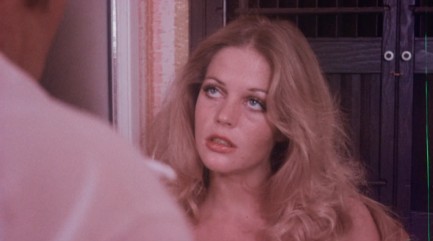 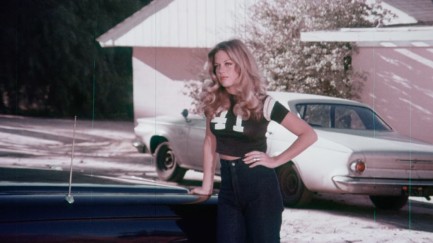 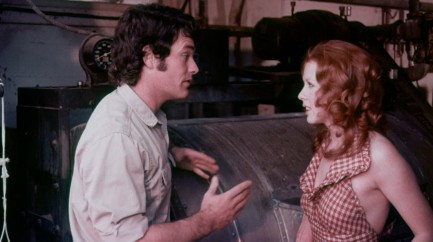 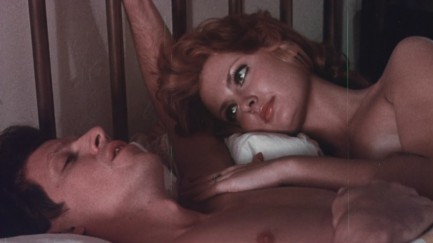 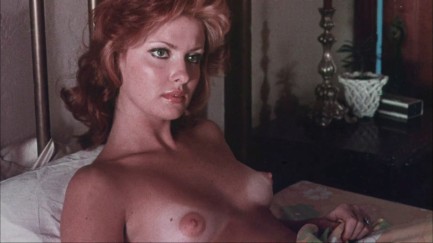 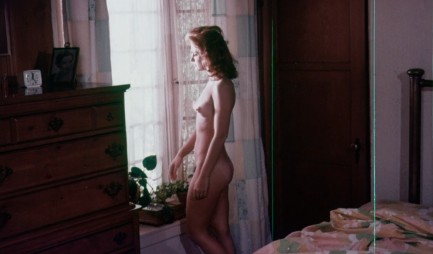 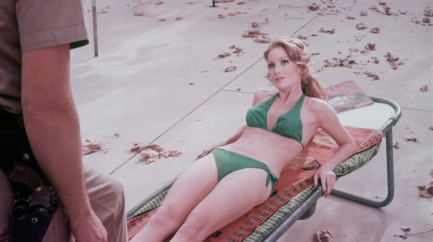 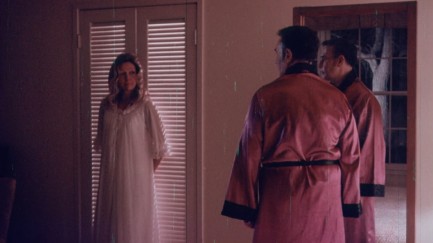 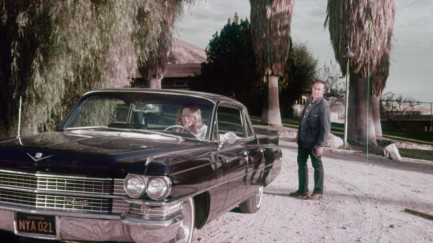 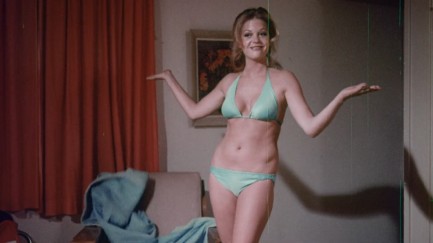  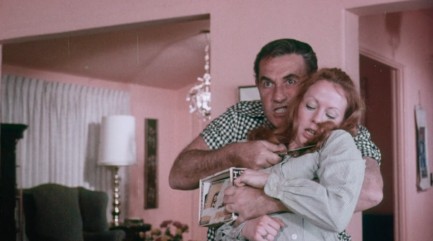 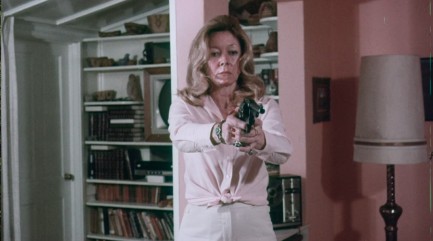 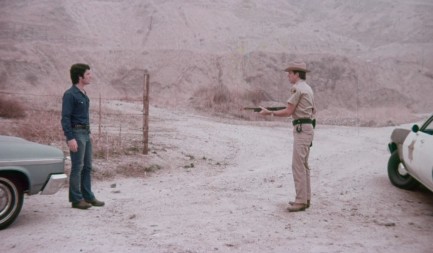
 Movie stars were always willing to give each other a hand. 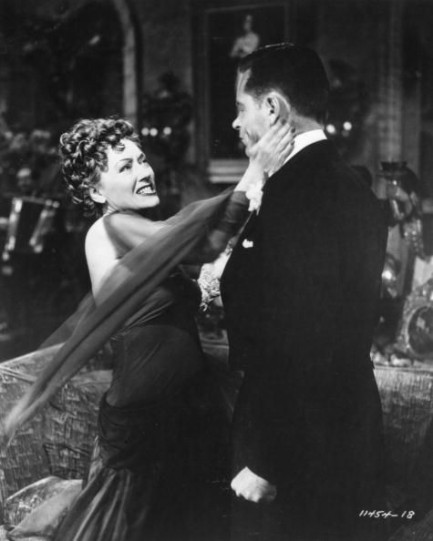
Once again we've been struck, so to speak, by the sheer number of cinema promo images featuring actors and actresses pretending to slap each other. The just keep turning up. The above shot is more about the neck than the face, but it still counts, as Gloria Swanson slaps William Holden in 1950's Sunset Boulevard. Below we have a bunch more, and you can see our previous collection at this link. Since we already discussed this phenomenon we won't get into it again, except briefly as follows: pretend slaps, film is not reality, and everyone should try to remember the difference. Many slaps below for your interest and wonder. 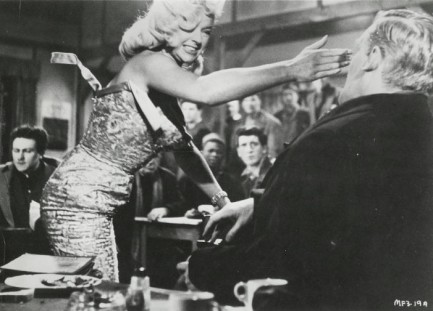 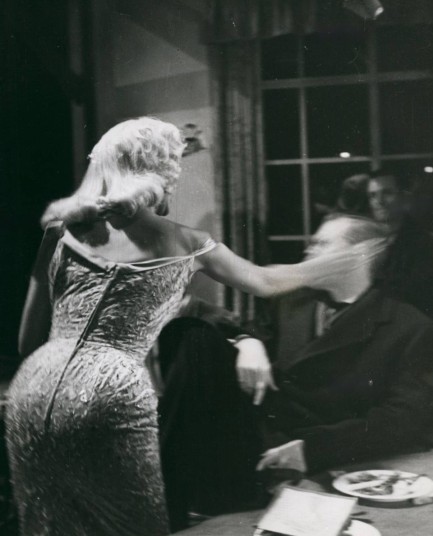 Diana Dors smacks Patrick Allen blurry in 1957's The Long Haul. Diana Dors smacks Patrick Allen blurry in 1957's The Long Haul.
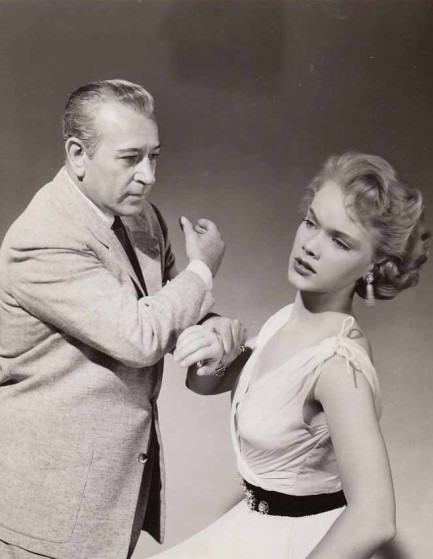 Mob boss George Raft menaces Anne Francis in a promo image made for 1954's Rogue Cop. Mob boss George Raft menaces Anne Francis in a promo image made for 1954's Rogue Cop.
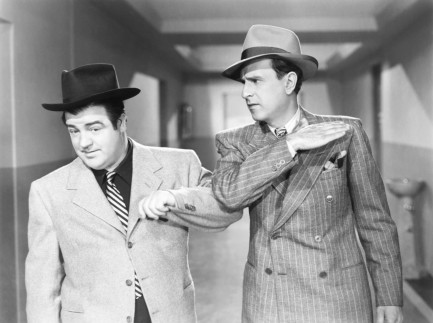 Bud Abbott gets aggressive with Lou Costello in 1945's Here Come the Co-Eds. Bud Abbott gets aggressive with Lou Costello in 1945's Here Come the Co-Eds.
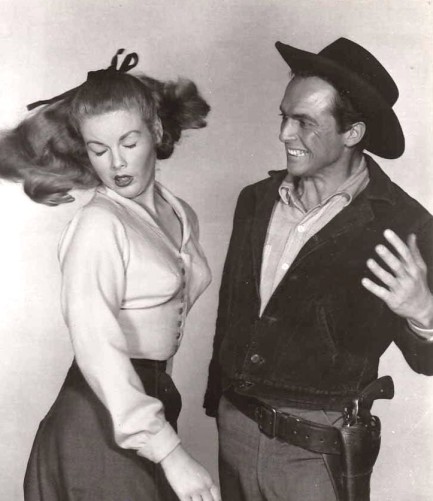 Jo Morrow takes one from black hat Jack Hogan in 1959's The Legend of Tom Dooley. Jo Morrow takes one from black hat Jack Hogan in 1959's The Legend of Tom Dooley.
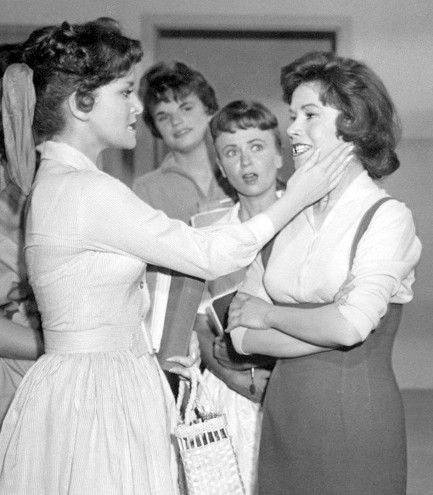 Chris Robinson and Anita Sands get a couple of things straight about who's on the yearbook committee in Diary of High School Bride. Chris Robinson and Anita Sands get a couple of things straight about who's on the yearbook committee in Diary of High School Bride.
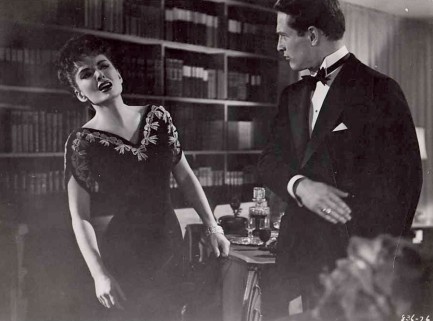 Paul Newman and Ann Blyth agree to disagree in 1957's The Helen Morgan Story. Paul Newman and Ann Blyth agree to disagree in 1957's The Helen Morgan Story.
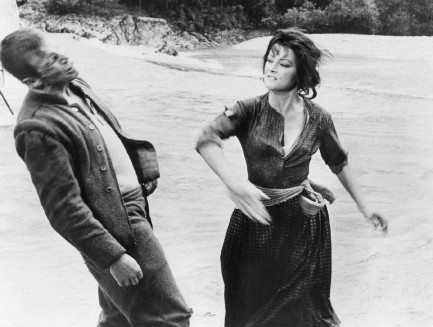 Verna Lisi shows Umberto Orsini who gives the orders in the 1967 film La ragazza e il generale, aka The Girl and the General. Verna Lisi shows Umberto Orsini who gives the orders in the 1967 film La ragazza e il generale, aka The Girl and the General.
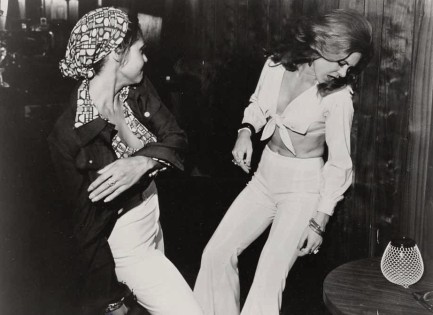 What the fuck did you just call me? Marki Bey slaps Betty Anne Rees loopy in the 1974 horror flick Sugar Hill. What the fuck did you just call me? Marki Bey slaps Betty Anne Rees loopy in the 1974 horror flick Sugar Hill.
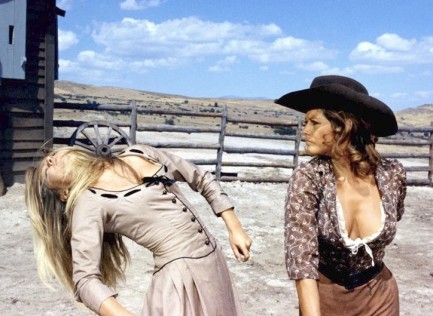 Claudia Cardinale slaps (or maybe punches—we can't remember) Brigitte Bardot in the 1971 western Les pétroleuses, known in English for some reason as The Legend of Frenchie King. Claudia Cardinale slaps (or maybe punches—we can't remember) Brigitte Bardot in the 1971 western Les pétroleuses, known in English for some reason as The Legend of Frenchie King.
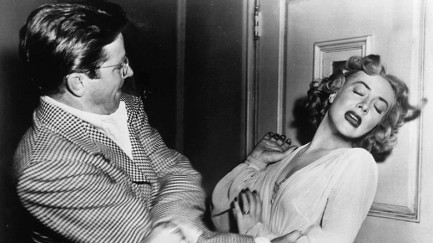 Audrey Totter reels under the attentions of Richard Basehart in 1949 Tension. We're thinking it was probably even more tense after this moment. Audrey Totter reels under the attentions of Richard Basehart in 1949 Tension. We're thinking it was probably even more tense after this moment.
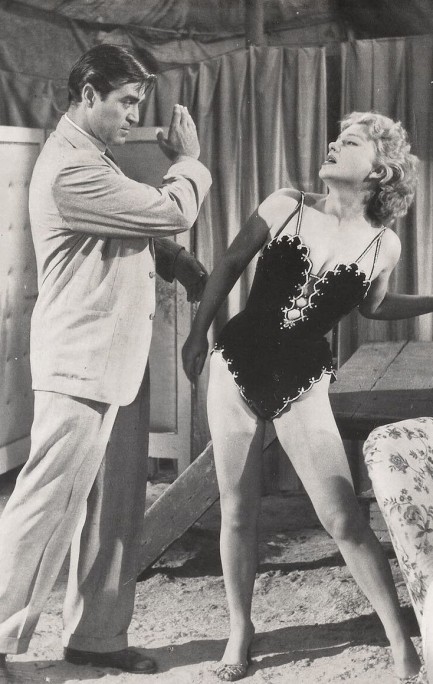 Anne Baxter tries to no avail to avoid a slap from heel Steve Cochran in 1954's Carnival Story. Anne Baxter tries to no avail to avoid a slap from heel Steve Cochran in 1954's Carnival Story.
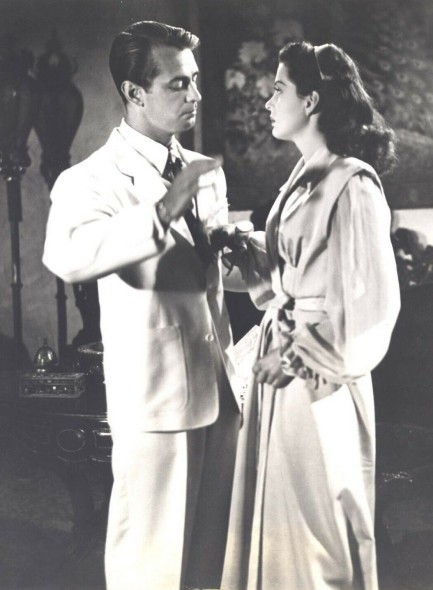 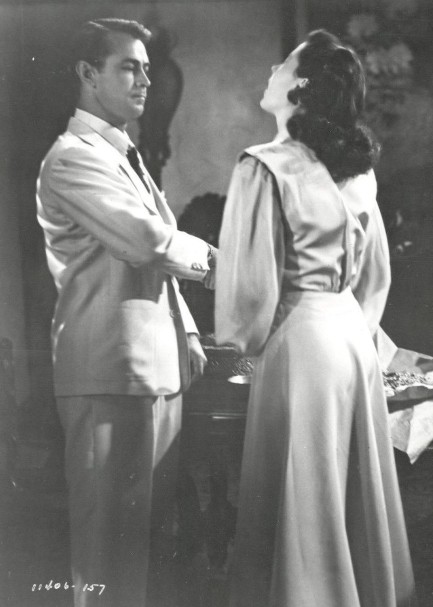 Though Alan Ladd was a little guy who Gail Russell probably could have roughed up if she wanted, the script called for him to slap her, and he obeyed in the 1946 adventure Calcutta. Though Alan Ladd was a little guy who Gail Russell probably could have roughed up if she wanted, the script called for him to slap her, and he obeyed in the 1946 adventure Calcutta.
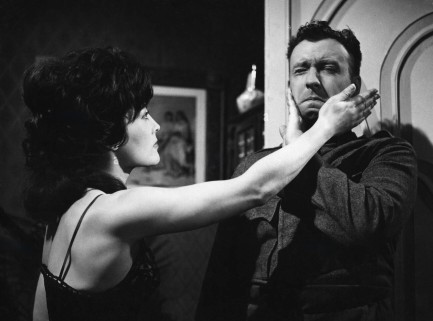 Peter Alexander guards his right cheek, therefore Hannelore Auer crosses him up and attacks his left in 1964's Schwejk's Flegeljahre, aka Schweik's Years of Indiscretion. Peter Alexander guards his right cheek, therefore Hannelore Auer crosses him up and attacks his left in 1964's Schwejk's Flegeljahre, aka Schweik's Years of Indiscretion.
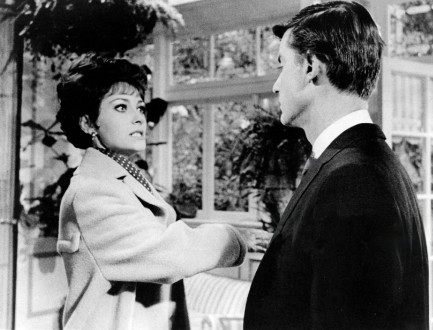 Elizabeth Ashley gives Roddy McDowall a facial in in 1965's The Third Day. Elizabeth Ashley gives Roddy McDowall a facial in in 1965's The Third Day.
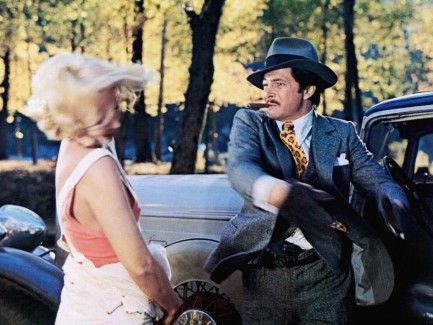 Tony Anthony slaps Lucretia Love in 1972's Piazza pulita, aka Pete, Pearl and the Pole. Tony Anthony slaps Lucretia Love in 1972's Piazza pulita, aka Pete, Pearl and the Pole. 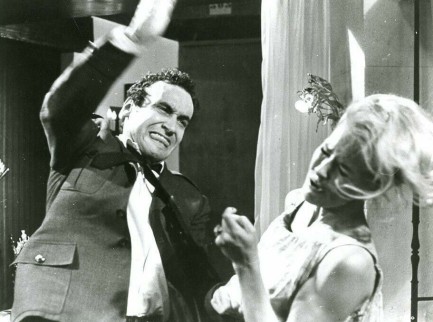 André Oumansky goes backhand on Lola Albright in 1964's Joy House. André Oumansky goes backhand on Lola Albright in 1964's Joy House.
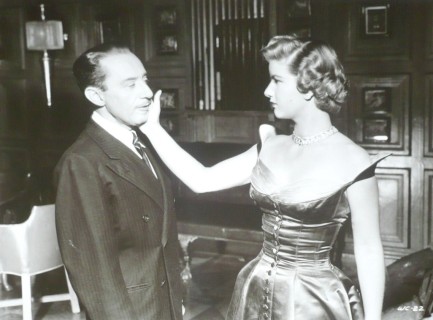 Frank Ferguson catches one from Barbara Bel Geddes in the 1949 drama Caught. Frank Ferguson catches one from Barbara Bel Geddes in the 1949 drama Caught.
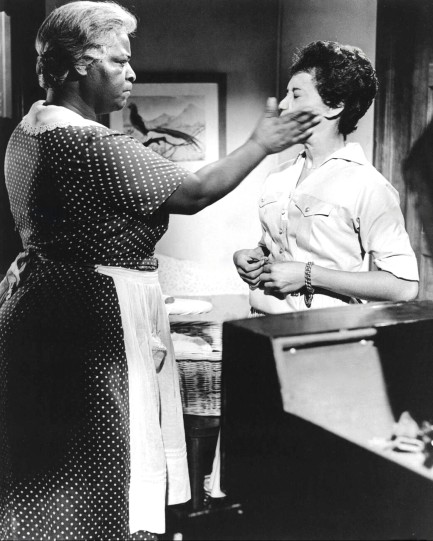 This looks like a real slap, so you have to credit the actresses for their commitment. It's from 1961's Raisin in the Sun and shows Claudia McNeil rearranging the face of Diana Sands. This looks like a real slap, so you have to credit the actresses for their commitment. It's from 1961's Raisin in the Sun and shows Claudia McNeil rearranging the face of Diana Sands.
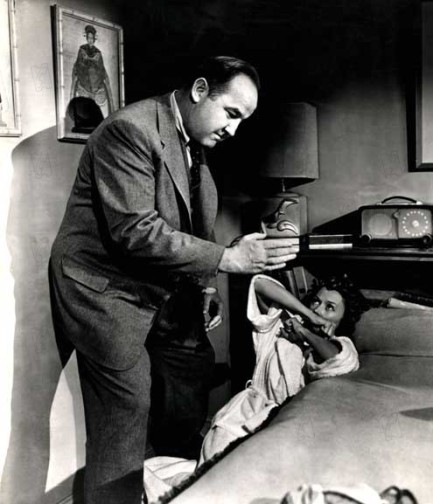 Gloria Grahame finds herself cornered by Broderick Crawford in 1954's Human Desire. Gloria Grahame finds herself cornered by Broderick Crawford in 1954's Human Desire.
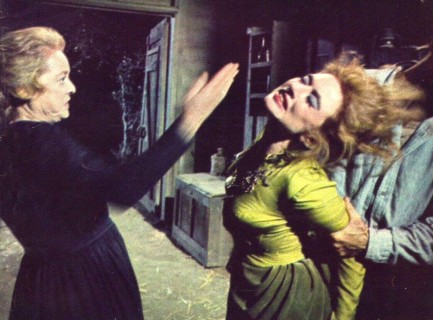 Bette Davis, an experienced slapper and slappee, gets a little assistance from an unidentified third party as she goes Old West on Amanda Blake in a 1966 episode of Gunsmoke called “The Jailer.” Bette Davis, an experienced slapper and slappee, gets a little assistance from an unidentified third party as she goes Old West on Amanda Blake in a 1966 episode of Gunsmoke called “The Jailer.”
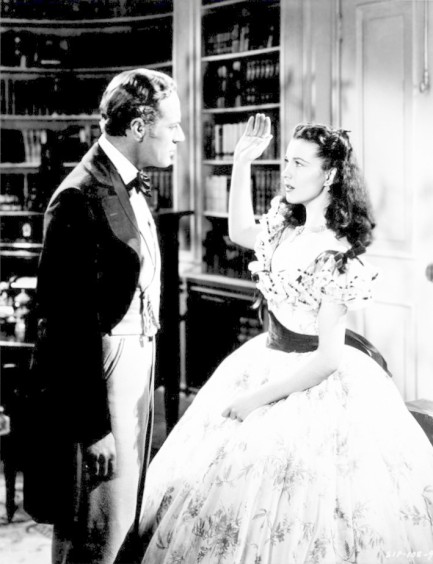 There are a few slaps in 1939's Gone with the Wind, so we had our pick. We went with Vivien Leigh and Leslie Howard. There are a few slaps in 1939's Gone with the Wind, so we had our pick. We went with Vivien Leigh and Leslie Howard.
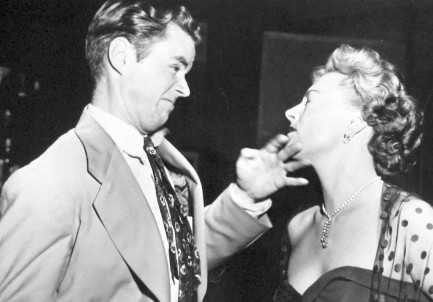 Virginia Field takes one on the chin from Marshall Thompson in Dial 1119. Virginia Field takes one on the chin from Marshall Thompson in Dial 1119.
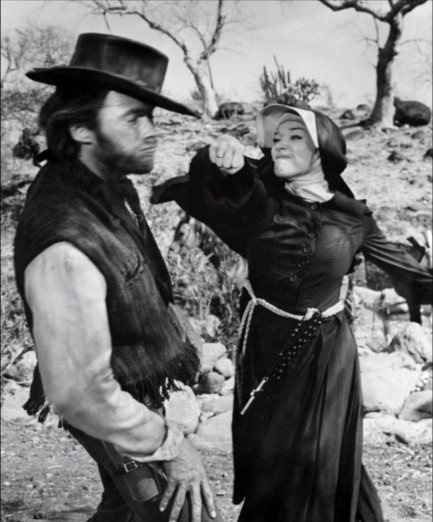 Clint Eastwood absorbs a right cross from nun Shirley MacLaine in 1970's Two Mules for Sister Sara. Clint Eastwood absorbs a right cross from nun Shirley MacLaine in 1970's Two Mules for Sister Sara.
 We'd probably regret it, but in this situation we'd take a good long look before running. 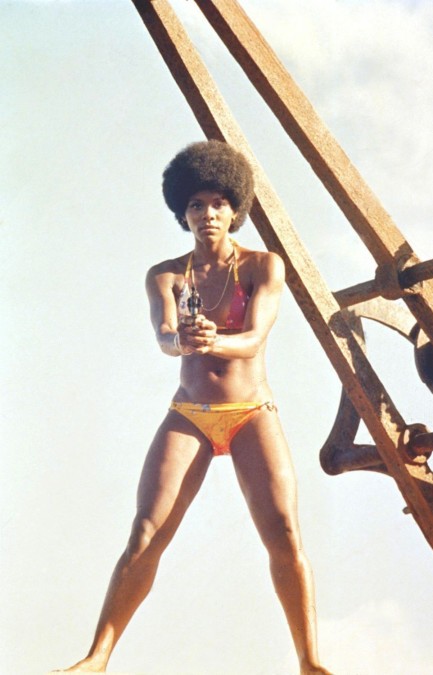
Yes, it's Gloria Hendry again. We've shown you a couple of her famed Uzi packing promo photos made for the James Bond flick Live and Let Die. In this image, also made for that film, she's ditched the rattling heavy weaponry for something a little more ergonomic. But based on appearances alone, we doubt she needed armaments of any sort to be seriously problematic for anyone who needed their behavior corrected. Her chisled body type was not the norm back in 1971 when the photo was made, but these days, in an era of numerous women action stars, she'd fit right in. See Gloria and her Uzi here.
 Interesting, full of stories, and very well read. 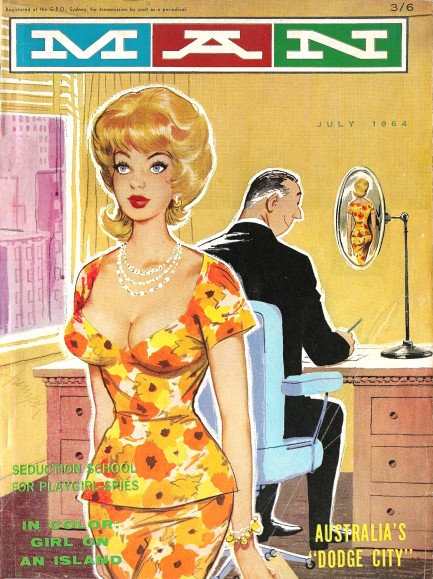
As much as we love K.G. Murray Publishing's men's magazine Adam, especially during its early 1970s period, we have to admit that the succinctly titled Man is probably the prettiest magazine ever produced by the Aussie company. Today's issue from this month in 1964 is an example. The colors explode from the pages. The art, some of which is by Jack Waugh and the single-monikered Humph, is detailed and lovingly rendered. The format is large (so much so that we had to scan every page you see here in two parts and assemble them in GIMP). And the stories are pure male wish fulfillment.
The magazine was such a popular offering that K.G. Murray even published a pocket edition, which we've already shown you. In today's full-sized edition, as always you get several beautiful models, including one supposedly named Van Leman posing on a sea turtle like it's a coin-operated ride outside a Kwik-E-Mart. We imagine the turtle wasn't happy about it, but how can you tell? It's a turtle. They never look happy. Man also provides a few celebrity shots, including of British actress Gloria Paul, and Danish flash-in-the pan Heidi Hansen. All that and more in many scans down under.
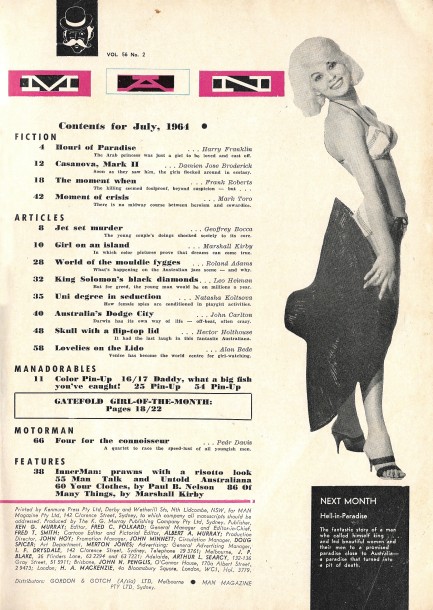 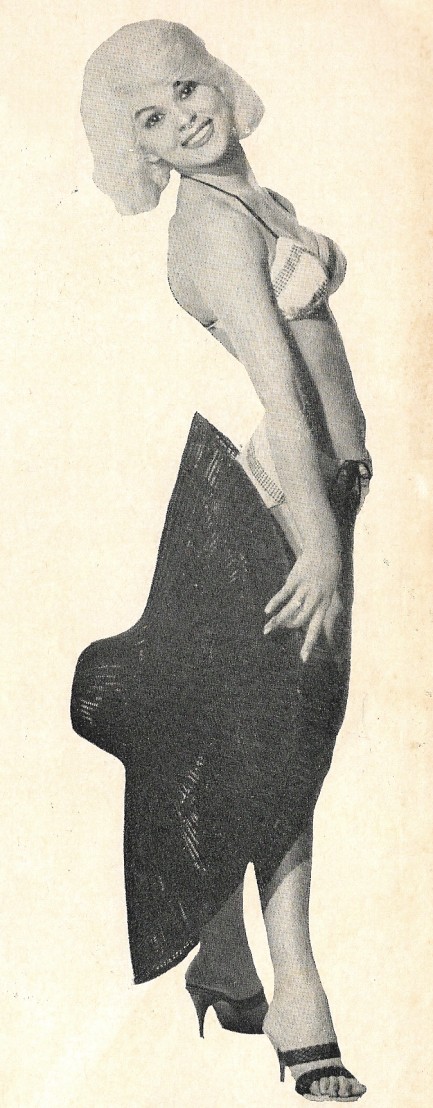 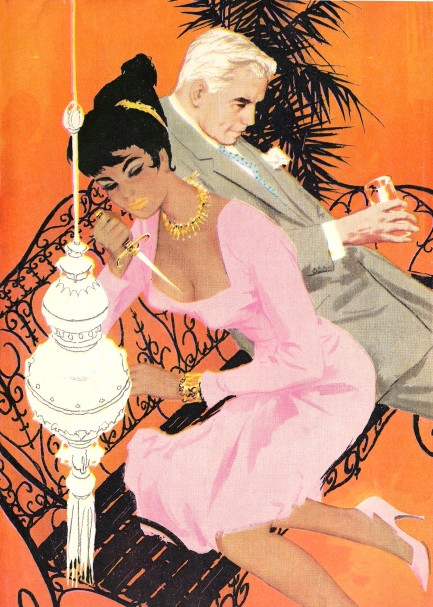 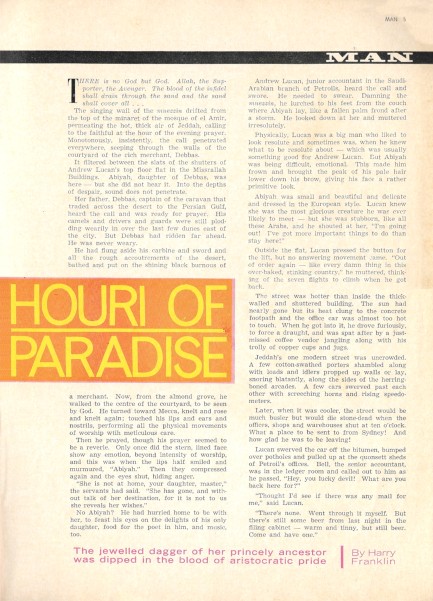 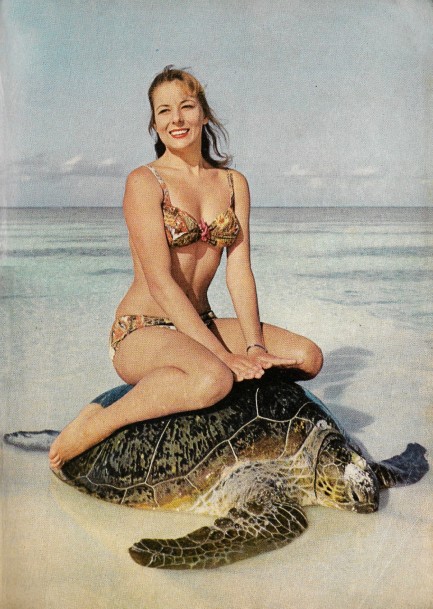 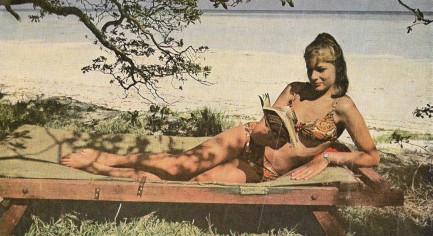 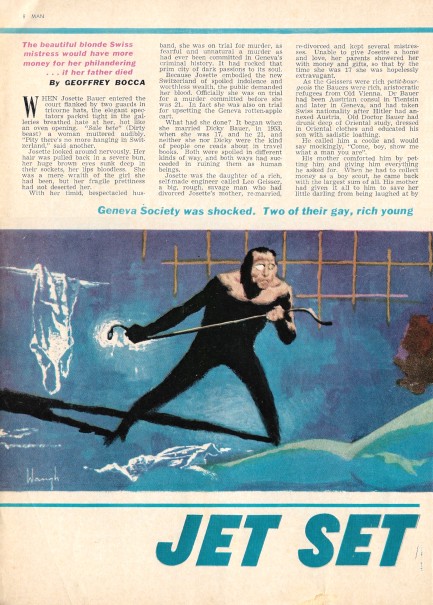 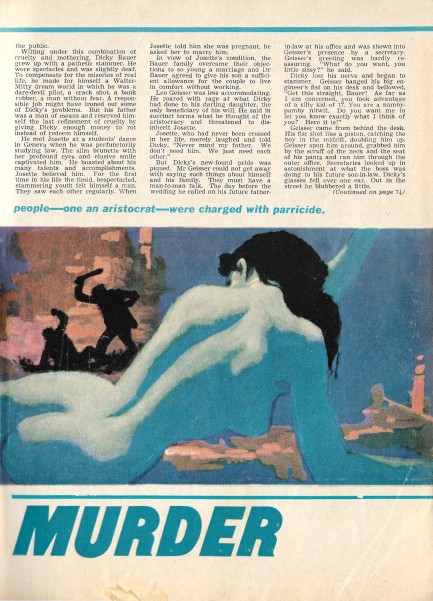 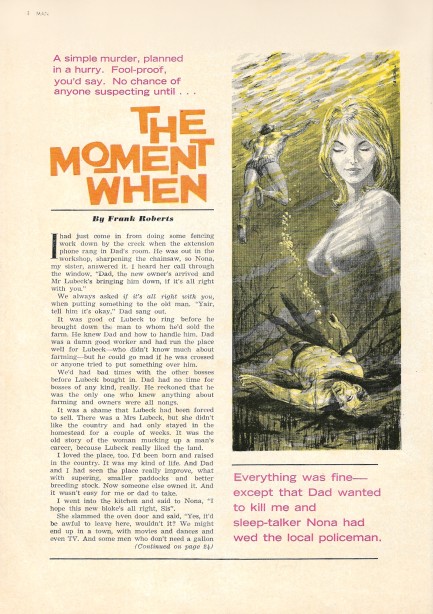 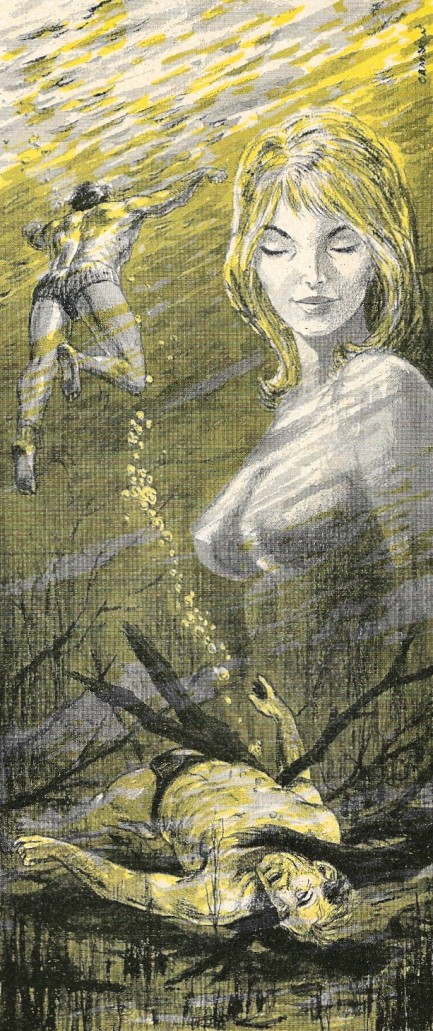 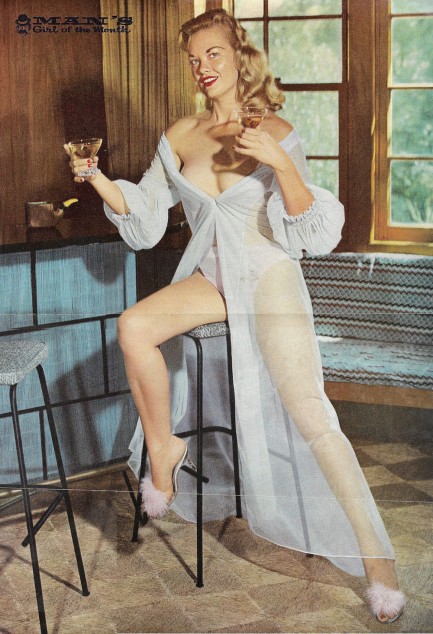   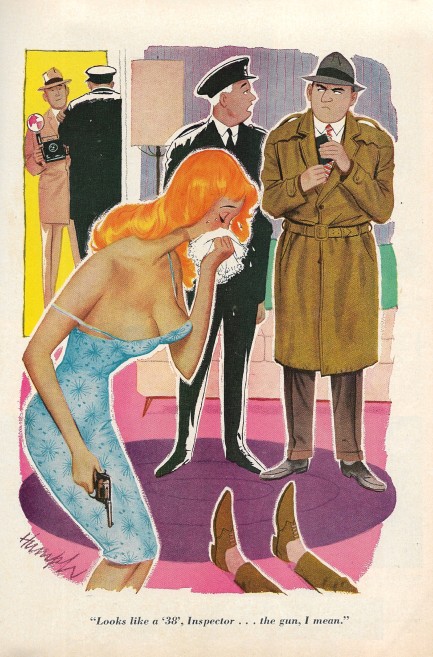 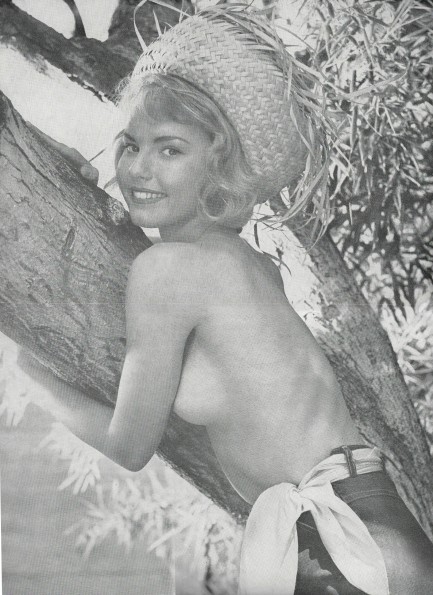 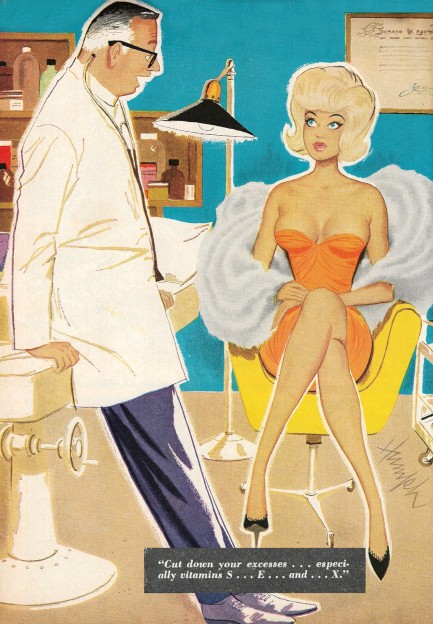 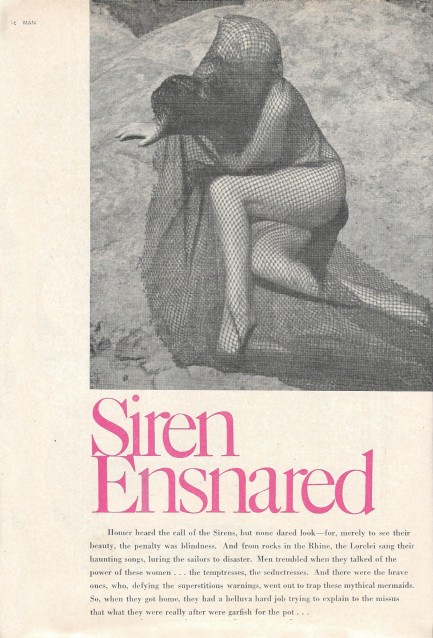 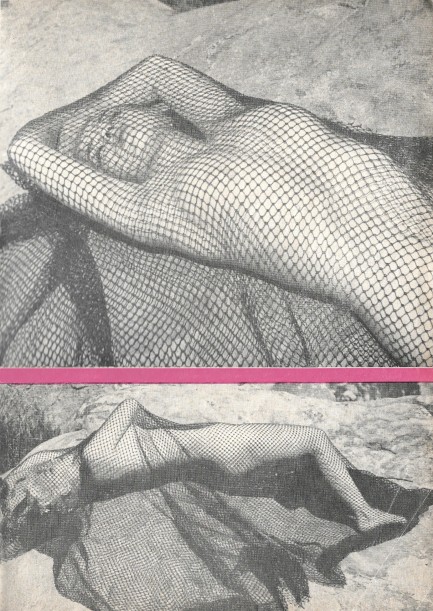 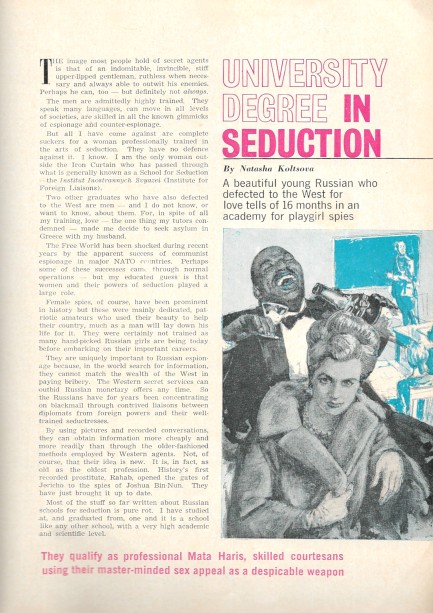 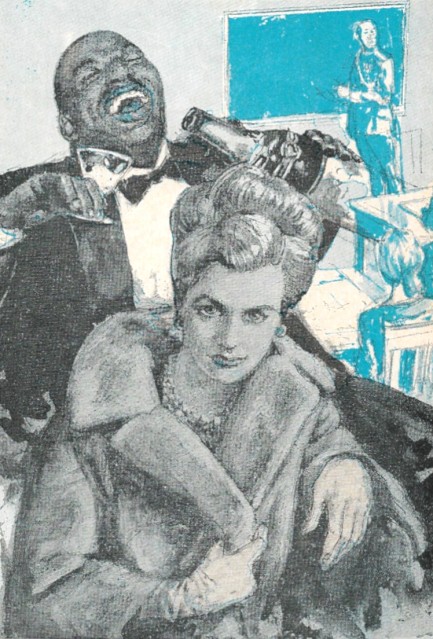 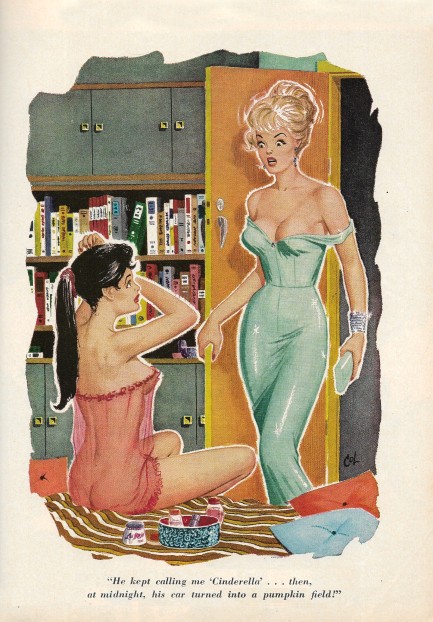 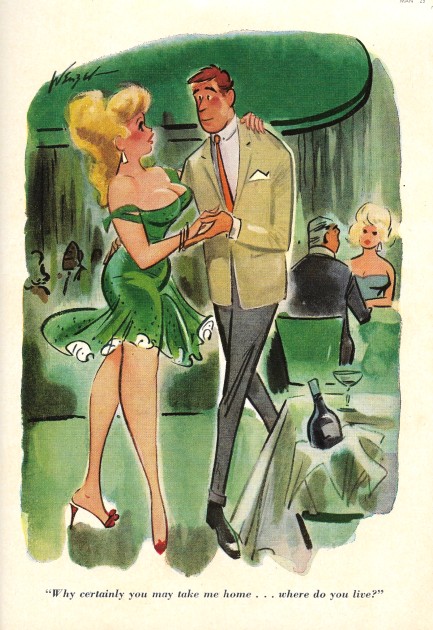 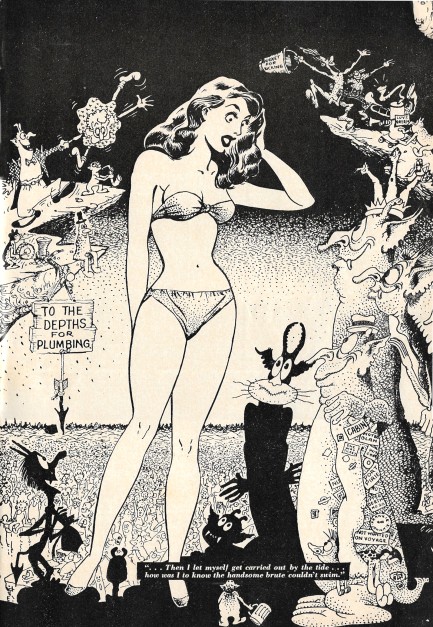 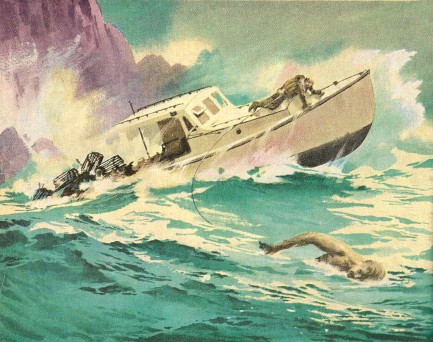 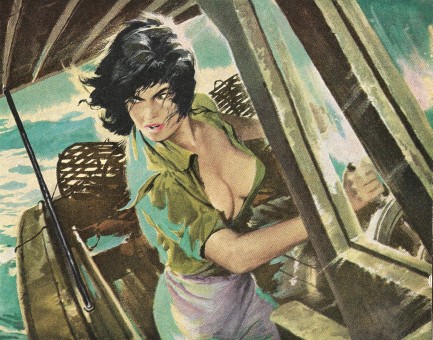 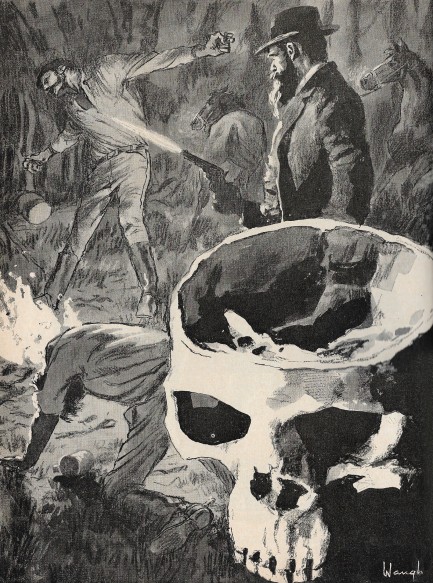 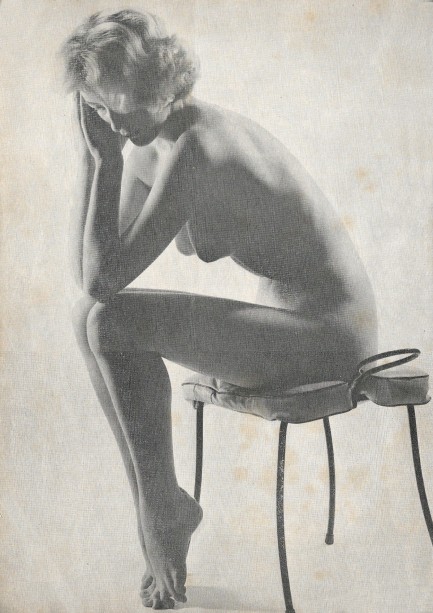 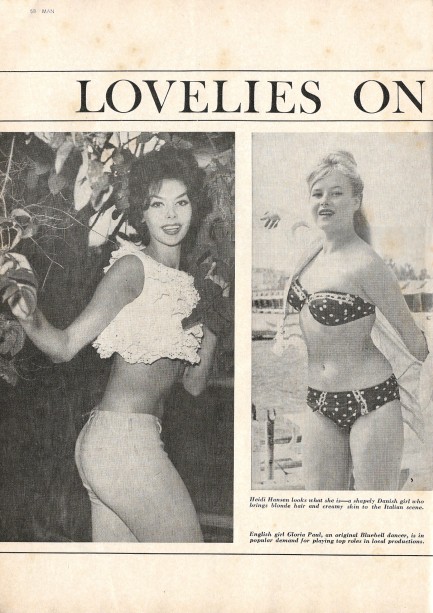  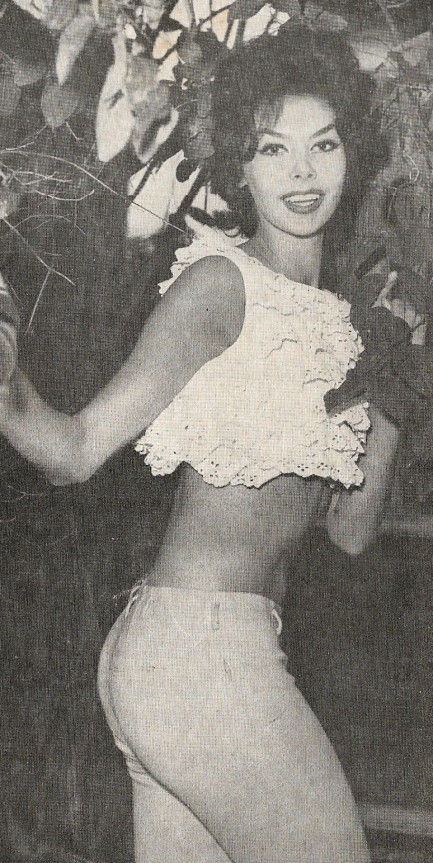 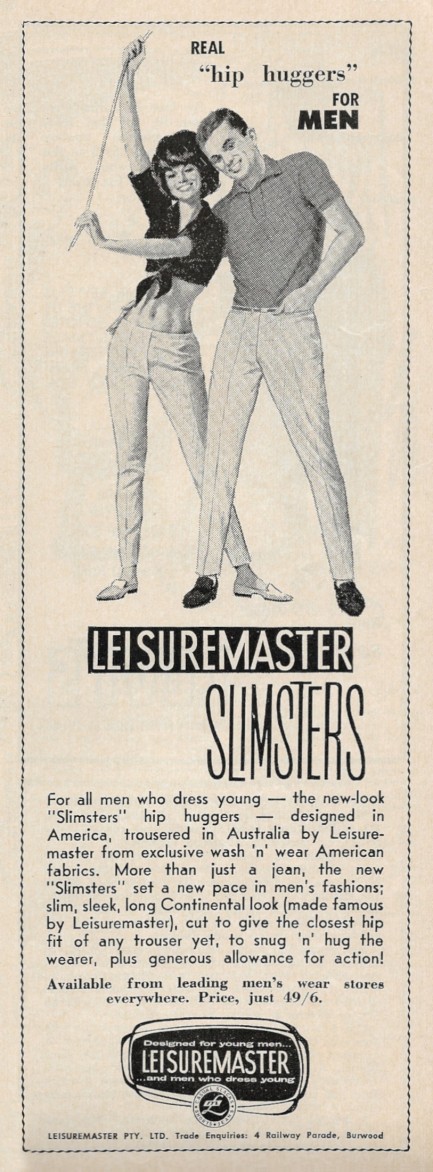 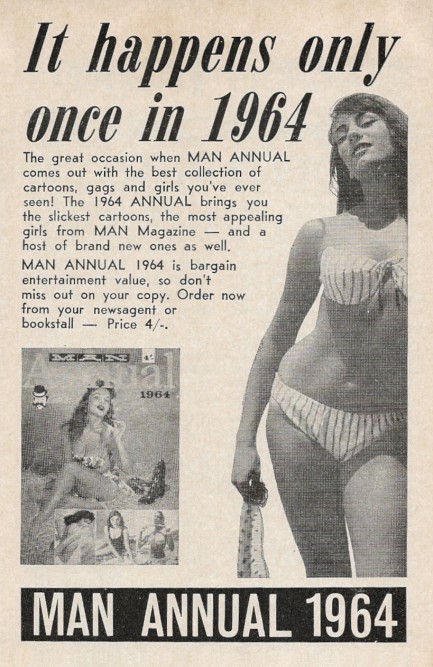
 Live fast, die young, and leave a terribly damaged corpse thanks to James Bond. 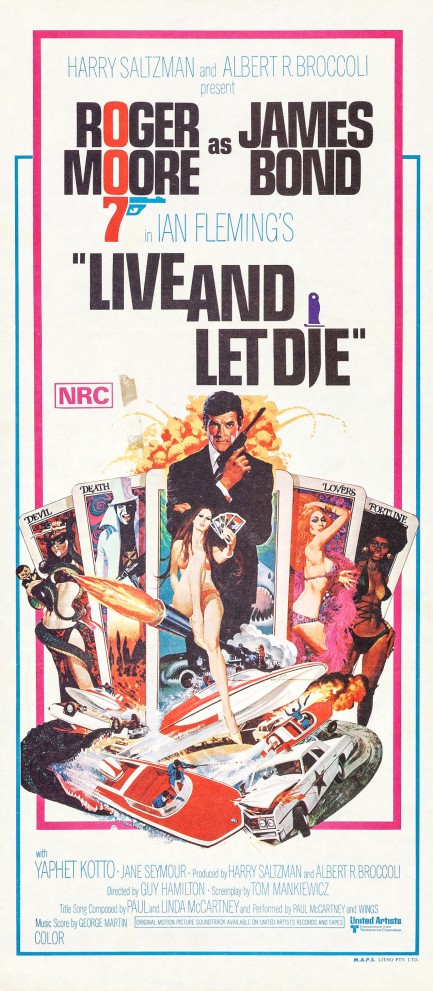
As with Shaft a few days ago, we can't add much new to the longtime assessments of 1973's Live and Let Die. We wouldn't discuss the film at all except that the posters were the work of illustration wizard Robert McGinnis. However, in light of our Shaft examination, there's an angle we can take: Live and Let Die was the first Bond movie to be clearly influenced by the diversification of Hollywood, becoming the first to include numerous black cast members in speaking roles. Since most participants in a Bond movie are there to get killed, including, often, all but one of the women he sleeps with, the rules didn't change even with the diversified cast. This leads to head villain Yaphet Kotto suffering perhaps the most brutal death in the franchise, and hottie Gloria Hendry departs for the hereafter too, which is criminal, in our view. But their participation was a landmark and gives Live and Let Die, even today, a different feel and look than the usual Bond fare.
On other fronts, Live and Let Die seems like the movie in which Bond stuntwork kicked into high gear, beginning a push that would soon extend beyond the bounds of earthly physics. The speedboat chase produced a then-world record aerial leap of 110 feet. On the acting front, newcomer Roger Moore displayed even at the outset of his Bond journey some of the cheeseball tendencies that would eventually take over his later portrayals, but it works fine. He was probably one of the best looking actors in the world in 1973, and while he doesn't have a chiseled physique, he's still everything and a free refill. We consider Live and Let Die to be one of two good Moore outings as Bond, along with The Man with the Golden Gun. It's certainly worth a watch, even if you've already seen it. And if you want to have a really fun night, watch it back-to-back with Shaft.
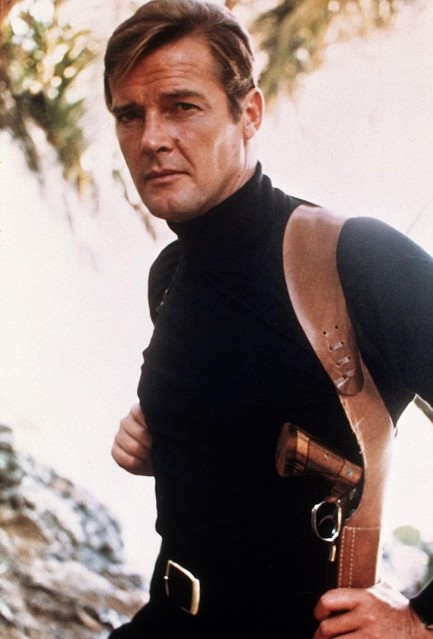 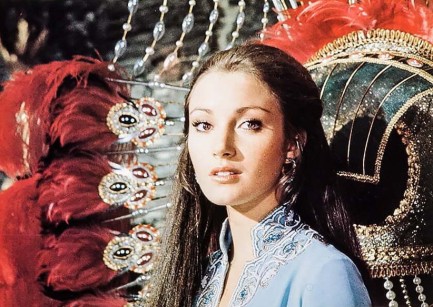  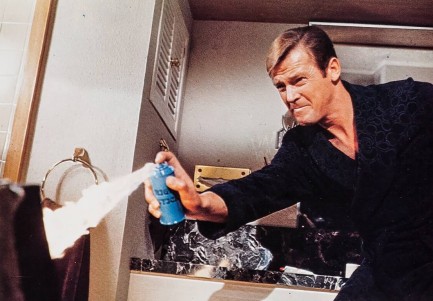 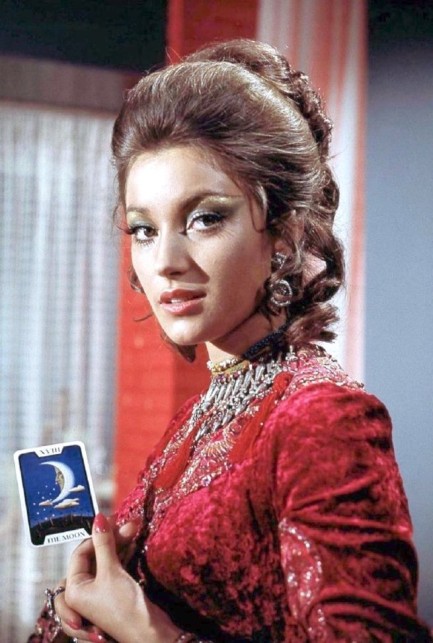 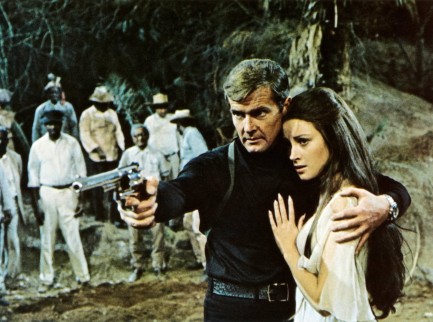 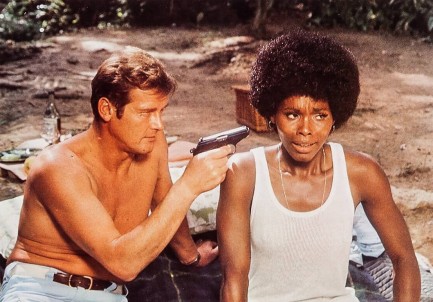 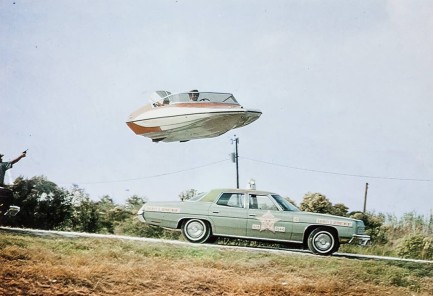  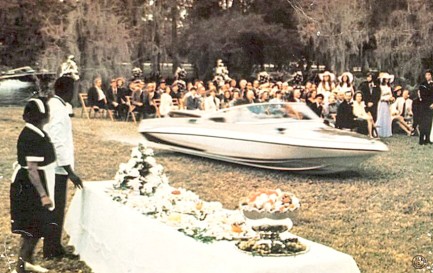 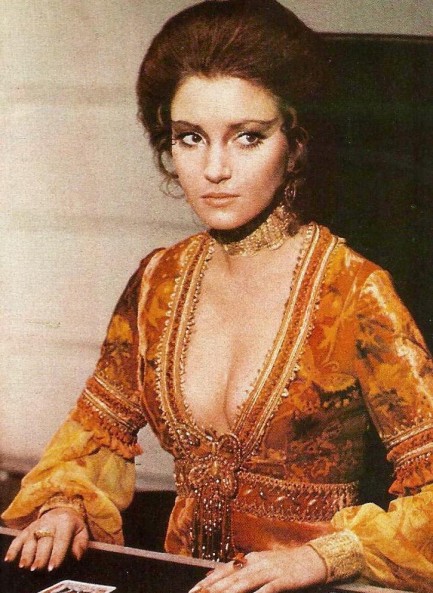  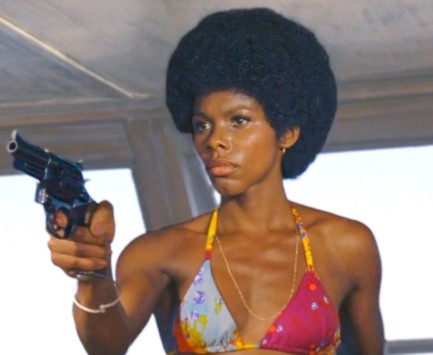 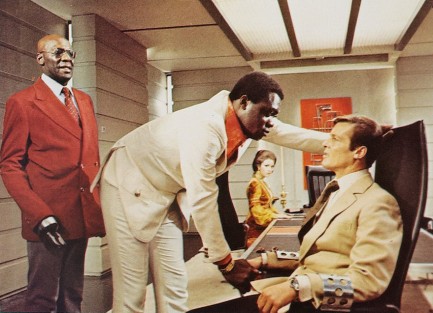 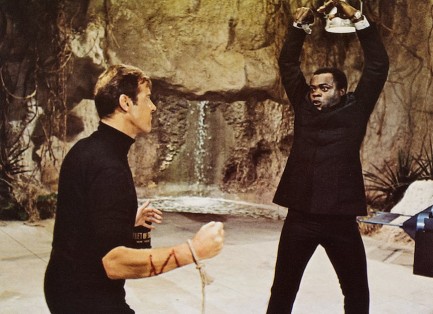 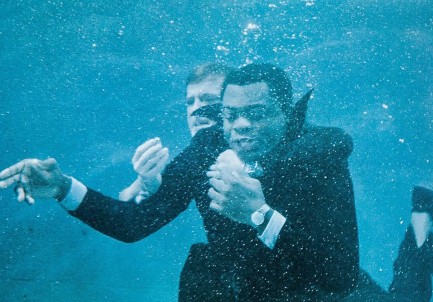 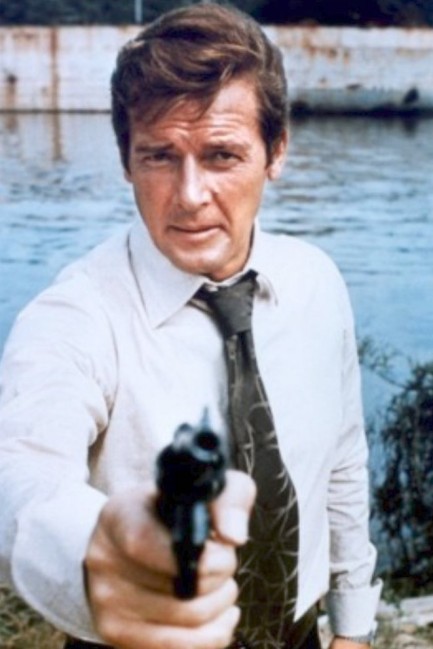 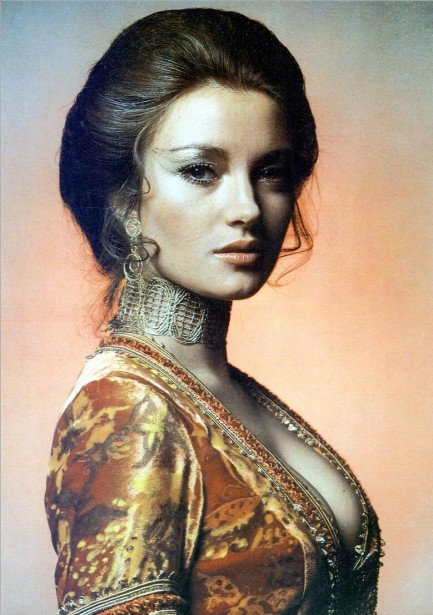 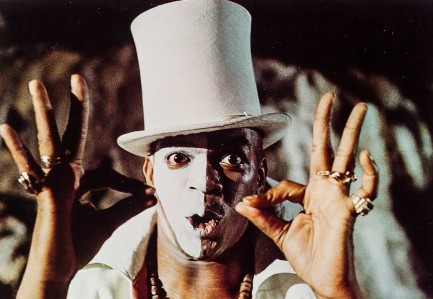 
 Justice is served—ice cold. 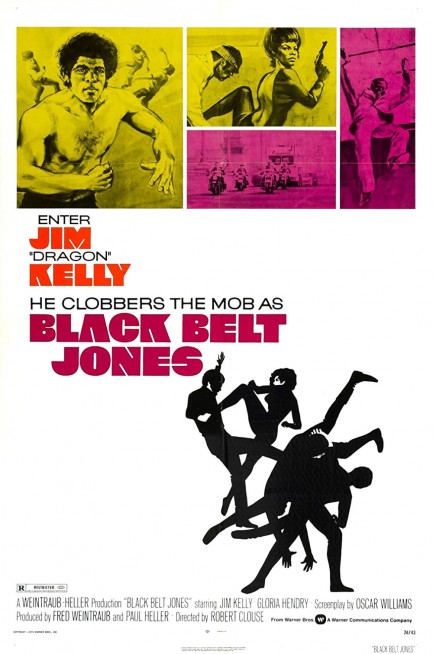
Above: poster art for the blaxploitation flick Black Belt Jones, starring Jim Kelly as the last man standing between honest folk and a mafia land grab. We talked about it last year, and you can read what we thought and see the Italian promo art by Ermano Iaia at this link. You can also see two nice Kelly promo shots here and here. The movie premiered in the U.S. today in 1974.
 Get away from him you bitches! 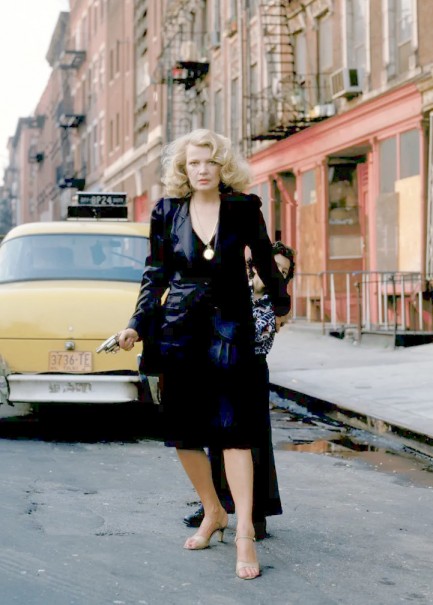
Many reviews of the classic movie Aliens point out the subtext of mother instinct rekindled under violent circumstances, but that idea predates Sigourney Weaver's awesome 1986 performance. The closest example we can think of is the 1980 thriller Gloria. Gena Rowlands, who you see above in full mama bear mode, tries to protect an eight-year-old boy from vicious animals (the Mafia) in a deadly and hostile place (the Bronx). Where Weaver has outlived her entire family due to hibernation in space and loves children, Rowlands is a gangster's moll who has outlived her childbearing years and claims to hate children. Both characters are catalyzed by a youngster's innocence, have a strong sense of justice, and face the longest possible odds. Do yourself a favor and watch the movie. Also: check the absolutely badass pose below. 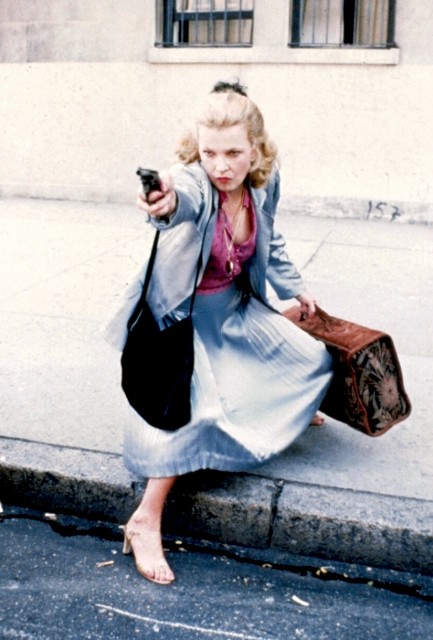
 You wouldn't believe the mischief I get up to inside this thing. 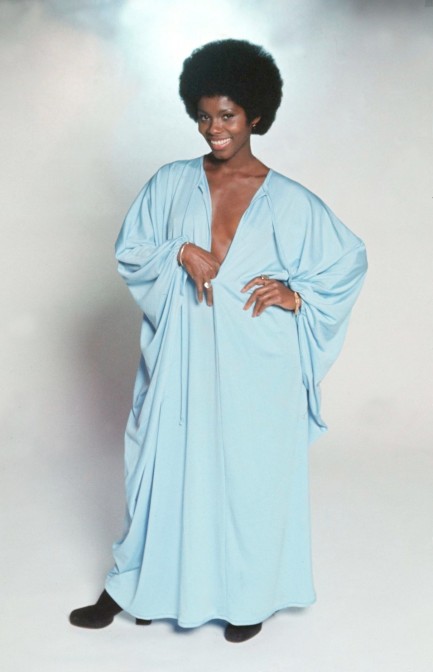
This wonderful 1973 promo image of U.S. actress Gloria Hendry demonstrates the adage “less is more,” as in less skin. We've shown you shots of her in a bikini, with her six-pack abs and muscled arms, but this voluminous kaftan does something special for her. It's like she's hiding a secret. We'll have more of Hendry later.
 Even Powell and Loy's legendary act was bound to get tired eventually. 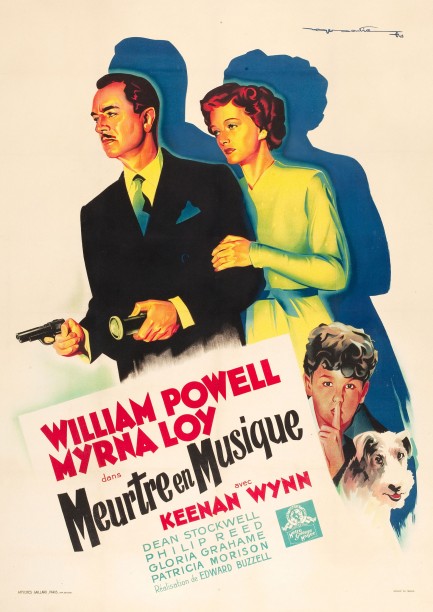
There's nice Roger Soubie art on this French poster for Song of the Thin Man, the last of six movies in the Thin Man series, which premiered in the U.S. in 1947 and reached France today in 1948. After six sessions the concept might seem a little worn to some viewers, but it still has William Powell and Myrna Loy as the leads. The mystery involves the death of an orchestra musician and the search for a missing bandleader, which leads to Powell and Loy exploring New York City's jazz underground. It's an all-white underground spread across various clubs, gambling boats, and parties, populated by at least fifty musicians, none of them of color. Of all the sight gags in the movie, the barring of black musicians from a film revolving around the art form they invented is the most notable one of all, but that's mid-century moviemaking for you.
The jazz gimmick is useful anyway, because it gives the filmmakers the opportunity to have Powell—as upper class supersleuth Nick Charles—play the role of a fish out of water. He understands neither the hipster jazzcats nor their customs and slang, and in about half a decade probably turns into the white-haired bartender from The Wild One. Even so, he needs to find and unmask a murderer in order to free a wrongly accused acquaintance from police custody. In true Thin Man fashion, he quips his way through the proceedings, plays cagey with femmes fatales Marie Windsor and Gloria Grahame, and finally unveils the killer in a nightclub populated by all the suspects. Loy is reliable as always in the sidekick role, and even amusingly picks up a few words of hep lingo.
While Dashiell Hammett originated the two characters of Nick and Nora Charles, he didn't touch Song of the Thin Man. Instead it was written by veteran crime novelist Steve Fisher and comedy writer Nat Perrin. Their union, unlike Nick and Nora's marriage, is an uneasy pairing, though it's hard to put a finger on what exactly is wrong. The mystery has an interesting backdrop, but is never compelling, while the humor seems clunkier than in the past. Powell and Loy do their best, but the movie failed to earn back its production budget, and the franchise came to an end. There were screenwriting and production issues, but we suspect that the real culprit was simple boredom—slayer of movie series and marriages alike. Audiences had simply moved on. World War, generational cynicism, and the emergence of grittier cinema will tend to cause that. Song of the Thin Man premiered today in 1947.
 Two tough guys plus one Gloria Grahame add up to minus one tough guy. 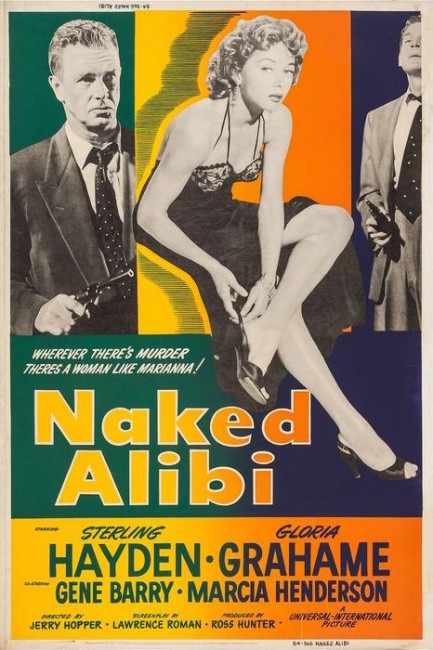
This rare promo for the film noir Naked Alibi shows Gloria Grahame caught between mortal enemies Sterling Hayden and Gene Barry. The movie premiered in the U.S. today in 1954. We talked about it last year. Shorter version: b movie tries hard but could b better.

|
 |

The headlines that mattered yesteryear.
1939—Batman Debuts
In Detective Comics #27, DC Comics publishes its second major superhero, Batman, who becomes one of the most popular comic book characters of all time, and then a popular camp television series starring Adam West, and lastly a multi-million dollar movie franchise starring Michael Keaton, then George Clooney, and finally Christian Bale. 1953—Crick and Watson Publish DNA Results
British scientists James D Watson and Francis Crick publish an article detailing their discovery of the existence and structure of deoxyribonucleic acid, or DNA, in Nature magazine. Their findings answer one of the oldest and most fundamental questions of biology, that of how living things reproduce themselves. 1967—First Space Program Casualty Occurs
Soviet cosmonaut Vladimir Komarov dies in Soyuz 1 when, during re-entry into Earth's atmosphere after more than ten successful orbits, the capsule's main parachute fails to deploy properly, and the backup chute becomes entangled in the first. The capsule's descent is slowed, but it still hits the ground at about 90 mph, at which point it bursts into flames. Komarov is the first human to die during a space mission. 1986—Otto Preminger Dies
Austro–Hungarian film director Otto Preminger, who directed such eternal classics as Laura, Anatomy of a Murder, Carmen Jones, The Man with the Golden Arm, and Stalag 17, and for his efforts earned a star on Hollywood's Walk of Fame, dies in New York City, aged 80, from cancer and Alzheimer's disease. 1998—James Earl Ray Dies
The convicted assassin of American civil rights leader Martin Luther King, Jr., petty criminal James Earl Ray, dies in prison of hepatitis aged 70, protesting his innocence as he had for decades. Members of the King family who supported Ray's fight to clear his name believed the U.S. Government had been involved in Dr. King's killing, but with Ray's death such questions became moot.
|

|
|

It's easy. We have an uploader that makes it a snap. Use it to submit your art, text, header, and subhead. Your post can be funny, serious, or anything in between, as long as it's vintage pulp. You'll get a byline and experience the fleeting pride of free authorship. We'll edit your post for typos, but the rest is up to you. Click here to give us your best shot.

|
|




















 Diana Dors smacks Patrick Allen blurry in 1957's The Long Haul.
Diana Dors smacks Patrick Allen blurry in 1957's The Long Haul. Mob boss George Raft menaces Anne Francis in a promo image made for 1954's Rogue Cop.
Mob boss George Raft menaces Anne Francis in a promo image made for 1954's Rogue Cop. Bud Abbott gets aggressive with Lou Costello in 1945's Here Come the Co-Eds.
Bud Abbott gets aggressive with Lou Costello in 1945's Here Come the Co-Eds. Jo Morrow takes one from black hat Jack Hogan in 1959's The Legend of Tom Dooley.
Jo Morrow takes one from black hat Jack Hogan in 1959's The Legend of Tom Dooley. Chris Robinson and Anita Sands get a couple of things straight about who's on the yearbook committee in Diary of High School Bride.
Chris Robinson and Anita Sands get a couple of things straight about who's on the yearbook committee in Diary of High School Bride. Paul Newman and Ann Blyth agree to disagree in 1957's The Helen Morgan Story.
Paul Newman and Ann Blyth agree to disagree in 1957's The Helen Morgan Story. Verna Lisi shows Umberto Orsini who gives the orders in the 1967 film La ragazza e il generale, aka The Girl and the General.
Verna Lisi shows Umberto Orsini who gives the orders in the 1967 film La ragazza e il generale, aka The Girl and the General. What the fuck did you just call me? Marki Bey slaps Betty Anne Rees loopy in the 1974 horror flick Sugar Hill.
What the fuck did you just call me? Marki Bey slaps Betty Anne Rees loopy in the 1974 horror flick Sugar Hill. Claudia Cardinale slaps (or maybe punches—we can't remember) Brigitte Bardot in the 1971 western Les pétroleuses, known in English for some reason as The Legend of Frenchie King.
Claudia Cardinale slaps (or maybe punches—we can't remember) Brigitte Bardot in the 1971 western Les pétroleuses, known in English for some reason as The Legend of Frenchie King. Audrey Totter reels under the attentions of Richard Basehart in 1949 Tension. We're thinking it was probably even more tense after this moment.
Audrey Totter reels under the attentions of Richard Basehart in 1949 Tension. We're thinking it was probably even more tense after this moment. Anne Baxter tries to no avail to avoid a slap from heel Steve Cochran in 1954's Carnival Story.
Anne Baxter tries to no avail to avoid a slap from heel Steve Cochran in 1954's Carnival Story.
 Though Alan Ladd was a little guy who Gail Russell probably could have roughed up if she wanted, the script called for him to slap her, and he obeyed in the 1946 adventure Calcutta.
Though Alan Ladd was a little guy who Gail Russell probably could have roughed up if she wanted, the script called for him to slap her, and he obeyed in the 1946 adventure Calcutta. Peter Alexander guards his right cheek, therefore Hannelore Auer crosses him up and attacks his left in 1964's Schwejk's Flegeljahre, aka Schweik's Years of Indiscretion.
Peter Alexander guards his right cheek, therefore Hannelore Auer crosses him up and attacks his left in 1964's Schwejk's Flegeljahre, aka Schweik's Years of Indiscretion. Elizabeth Ashley gives Roddy McDowall a facial in in 1965's The Third Day.
Elizabeth Ashley gives Roddy McDowall a facial in in 1965's The Third Day. Tony Anthony slaps Lucretia Love in 1972's Piazza pulita, aka Pete, Pearl and the Pole.
Tony Anthony slaps Lucretia Love in 1972's Piazza pulita, aka Pete, Pearl and the Pole. André Oumansky goes backhand on Lola Albright in 1964's Joy House.
André Oumansky goes backhand on Lola Albright in 1964's Joy House. Frank Ferguson catches one from Barbara Bel Geddes in the 1949 drama Caught.
Frank Ferguson catches one from Barbara Bel Geddes in the 1949 drama Caught. This looks like a real slap, so you have to credit the actresses for their commitment. It's from 1961's Raisin in the Sun and shows Claudia McNeil rearranging the face of Diana Sands.
This looks like a real slap, so you have to credit the actresses for their commitment. It's from 1961's Raisin in the Sun and shows Claudia McNeil rearranging the face of Diana Sands. Gloria Grahame finds herself cornered by Broderick Crawford in 1954's Human Desire.
Gloria Grahame finds herself cornered by Broderick Crawford in 1954's Human Desire. Bette Davis, an experienced slapper and slappee, gets a little assistance from an unidentified third party as she goes Old West on Amanda Blake in a 1966 episode of Gunsmoke called “The Jailer.”
Bette Davis, an experienced slapper and slappee, gets a little assistance from an unidentified third party as she goes Old West on Amanda Blake in a 1966 episode of Gunsmoke called “The Jailer.” There are a few slaps in 1939's Gone with the Wind, so we had our pick. We went with Vivien Leigh and Leslie Howard.
There are a few slaps in 1939's Gone with the Wind, so we had our pick. We went with Vivien Leigh and Leslie Howard. Virginia Field takes one on the chin from Marshall Thompson in Dial 1119.
Virginia Field takes one on the chin from Marshall Thompson in Dial 1119. Clint Eastwood absorbs a right cross from nun Shirley MacLaine in 1970's Two Mules for Sister Sara.
Clint Eastwood absorbs a right cross from nun Shirley MacLaine in 1970's Two Mules for Sister Sara.


































































